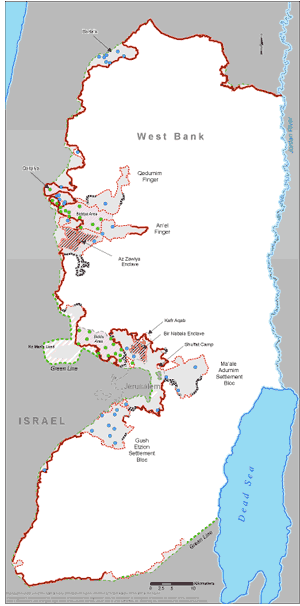Raad Amer
November 7, 2009
Fifty-three years ago my family was massacred by a unit in the Israeli army known as The Border Guard. Fourty-nine innocent civilians from the village of Kufur Kasem were murdered. Fifteen of those were close family members. Their sin was to go back to their homes, unknowingly violating a curfew imposed by the Israeli army.
Back then Israel regarded all Palestinian/Arab citizens of Israel as a hostile population (Wikipedia, par. 4). They were treated as mistrustful people that have no loyalty to Israel. The Israeli government kept them under strict supervision, and gave the army full control over them. The army unit that took charge was called The Border Guard. This is the same unit that declared a curfew in Kufur Kasem at 5:00pm on October 29, 1956, and committed the massacre. Haitam Sabbah describes the circumstances of the curfew:
They reached Kafr Qasem around 4:45 pm and informed the Mukhtar who protested that there are about 400 villagers working outside the town and there is no enough time to inform them of the curfew timings. An officer assured him that they will be taken care of (How can an order be given to shoot children, para. 6).
When the sudden and unusual curfew was imposed, the Border Guard unit commander asked his superiors what about those villagers who did not hear or know about the curfew? According to Kufur Kasem page on wikipedia, “To this Col. Issachar replied in crystal clear words, 'I don't want sentimentality and I don't want arrests, there will be no arrests'.†(Kafr Qasim massacre, para.6). Samia Halaby, a researcher and artist has created a gallery exhibition about the massacre. She conducted interviews with eyewitness and survivors. She wrote on her webpage describing the massacre, “The massacre at Kafr Qasem occurred in waves as the unfortunate workers returned from their work in the fields at different times. There were nine waves†(2006, para.22). After the massacre took place that day, Israel tried to whitewash the crime scene, but it was too bloody and red for it to be erased from history.
Israel did all it could do to hide the crime. But the horrors on the ground were too great. Despite the censorship that Israel applied on the village, a group of Arab Knesset Members and a Communist Party member managed to break the siege and get into the village, a week after the massacre, to report that later to the media.
Fifty-three years later, those who committed this horrible massacre are still free from any prosecution. At the beginning Israel issued high sentences against the commanders who were involved, but within the flowing two years all were released. Israel has a history of honoring its professional killers proudly. Most likely those commanders enjoy lots of privileges that are not given to the normal Israel soldier. Then Israeli Prime Minister, David Ben Gurion, commented on the massacre at a cabinet meeting saying: “We have a wonderful army, but it appears that sometimes there are incidents and circumstances that make people lose their minds.†In fact, what he said has revealed a policy that is conducted after every massacre or crime the Israel army commits against the Palestinians. Israel has always claimed to have the “most moral army in the worldâ€, and when something too big to cover-up happens, Israel creates its own mock investigation committees to continue the role play. Propaganda prosecutions are always there to present the beautiful image of the only democracy in the Middle East.
The massacre was never an isolated incident but it was part of a state-organized terror campaign against its Palestinian citizens. The importance of this massacre is it is one of the early ones under the newly formed state of Israel and it created some protests in Israel. Al Qryia Net followed an investigation done by an Israeli Journlaist, Rupik Rozenthal, in 1991 and wrote on its website:
Only in 1991, part of the truth started to come out. Rupik Rozenthal, an Israeli journalist, wrote in "Hadashot" on 25 November saying the massacre was part of an overall plan by the Israeli army to deport as many Palestinians as possible out of the country. Rozenthal was allowed to go through the army archives and read the minutes of the military trial of the 11 soldiers and officers who were involved in the massacre. He found out that the plan was to try and move the Palestinians out of the Arab villages in the Triangle and send them into Jordan should the latter intervenes in support for Egypt. Jordan did not enter the 1956 war. The plan was not carried out in full. Only the first phase was done. The dire price was 49 villagers from Kufr Qassem.
Fifty-three years later and the wounds are still open and hurting. The families of the 49 are looking for the missing justice, and hoping that their healing process will start soon to reduce the amount of pain that has been endured as a result of this horrible massacre.
References
Halaby, Samia, A. Kafr Qasem Memorial Exhibition 1956. (2006, October). In ARTWORK of Samia A. Halaby. Retrived 18:40, November 5, 2009, from http://www.art.net/~samia/Fiftieth/massacre.html
Kafr Qasim massacre. (2009, October 7). In Wikipedia, The Free Encyclopedia. Retrieved 15:45, November 5, 2009, from http://en.wikipedia.org/w/index.php?title=Kafr_Qasim_massacre&oldid=318436619
Sabbah, Haitham. Kfar Kassem massacre: How can an order be given to shoot children? (2009). Sabbah Report. Retrived 10:51, November 5, 2009, from http://sabbah.biz/mt/archives/2008/10/29/kfar-kassem-massacre-how-can-an-order-be-given-to-shoot-children
Kufr Qassem: 40 Years Later And The Wounds Are Still Fresh Survivors Of Horrible Massacre Recall Their Ordeal (1999). In Al-Qaryiah Net. Retrieved 11:05, November 5, 2009, from http://www.kufur-kassem.com/cms/content/view/148/35/1/1/
